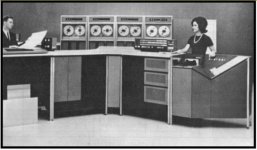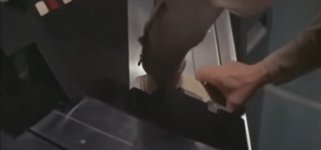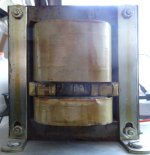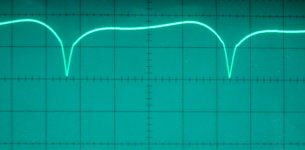commodorejohn
Veteran Member
God that really was the most Saul Bass looking computer ever made.
I read somewhere that Honeywell did employee design consultants on its development but I don't know who they were. A lot of thought seems to have gone into not just the internal technology but the ergonomics and visual appeal. It seems obvious that simple coloured symbols on the buttons would catch the eye of an operator more clearly than words once the meaning of the symbols was known.God that really was the most Saul Bass looking computer ever made.

The IBM 1402 reader/punch, among other bits of IBM unit-record equipment could be had with the slanted input tray. See here for example.
I liked the vibratory table feed on the CDC 405 reader with vacuum feed. CDC used this design for a long time. https://commons.wikimedia.org/wiki/File:CDC405Top.jpg



OK, so the output of that transformer should be a sine wave 50Hz signal. That makes the odd waveforms more curious. Sounds like some "bad" components someplace? Could be diodes, too.

I should mention that I got the windings mixed up in my previous post. The bottom winding is the mains primary and the constant voltage winding is overlaid onto the low voltage output windings. I have just checked the bundle of wires coming from the windings.Ah, I had missed the CVT aspect. Although, I wonder how that extra winding, being disconnected, could be interfering at all. That got me thinking, though, about the fact that you have two transformers working in (possibly) close proximity. How nearby is the 220-110 transformer to the 110-15 one? Maybe tip one 90 degrees so that the magnetic fields won't align?
Without the capacitor connected to the Ferroresonant coil you will get very little out of the low voltage windings on the transformer.
And, as I mentioned in another thread, the waveform coming out of the output of a constant voltage transformer is not pretty. See:https://www.eeeguide.com/constant-voltage-transformer-cvt/ for example. Essentially, a square wave superimposed on a sine wave, or vice-versa.
Note also, that the value of the tank capacitor has to be adjusted if you're going from 60Hz to 50Hz applications. They don't call it "ferroresonant" for no reason.
Nope, a CVT outputs a trapezoidal waveform, basically a summation of the energy stored in the tank circuit with the secondary sinusoidal output. See, for example, https://www.nutsvolts.com/questions-and-answers/ferroresonance-transformer. Basically, a clipped-top sinusoid. CVTs are great for taking up the slack when the line supply drops--they can usually handle a 40% drop in line voltage. But there's a price to pay. If overloaded, the output voltage drops like a rock. They're much less efficient than regular transformers and oddly, as load current drops, so does efficiency. Because of input surge requirements, they tend to be oversized for the constant load requirements, thus operating in their least efficient mode. As a result, they tend to run hot.That's odd about the waveform because I have read that a CVT will actually output an even better sinusoidal wave than the one input because of the resonant circuit involved. The equipment that the PSUs were removed from had already been adapted by Honeywell for use in the UK, so hopefully they dealt with the tuning of the resonant circuits for 50Hz operation

Wires retaining their shape may be the result of insulation hardening with age but it may be possible that the copper itself experiences long term age hardening as well as the well known work hardening. In my control panel I found a few wires that had snapped, the copper itself fracturing cleanly across leaving a crystalline pattern on the broken ends. We are used to thinking of copper as being very ductile but that isn't always true.One thing's for sure with Honeywell...the wires they used as well as the zip ties were made to last! I've been rewiring a control panel for the last 2 weeks and the wires are like "memory wire" and want to retain their shape. The zip ties are like new. I have some newer ones (probably from Harbor Freight) that went brittle in less than 10 years.
